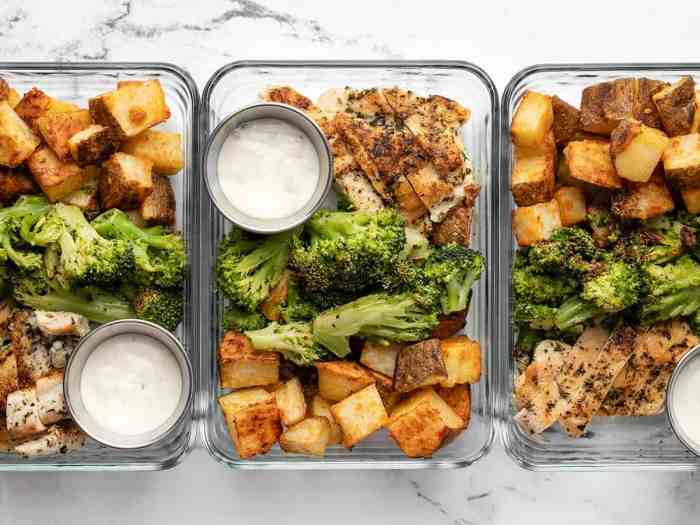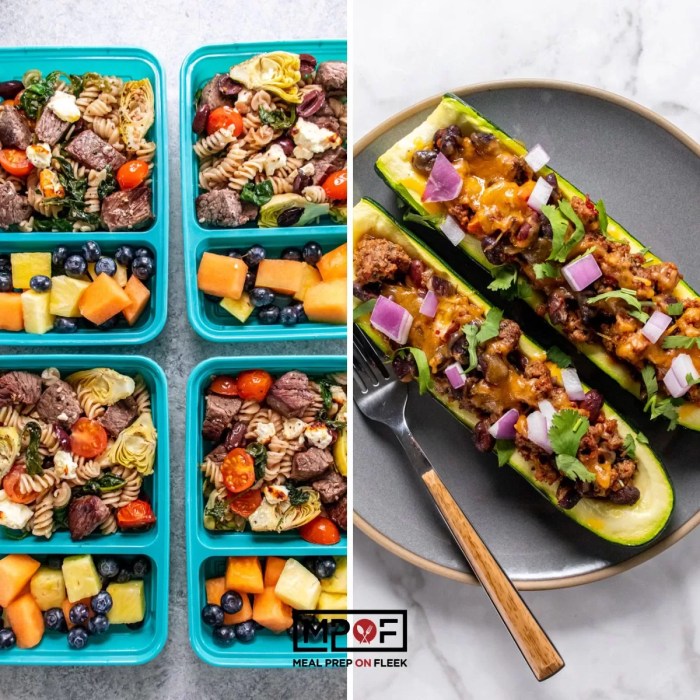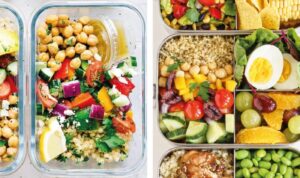Meal Prep Ideas are all the rage these days, helping you plan, prep, and save time and money while eating healthy. From essential tools to special diet options, get ready to dive into the world of meal prepping in style.
Introduction to Meal Prep Ideas

Meal prep is the practice of preparing meals ahead of time, usually for a week, to save time and make it easier to stick to a healthy eating plan. It involves cooking and portioning out meals so they are ready to eat when you need them. The benefits of meal prep include ensuring you have nutritious meals readily available, helping you avoid unhealthy fast food options, and saving money by buying ingredients in bulk.
Why Meal Prep is Essential for a Healthy Lifestyle
Meal prep is essential for a healthy lifestyle because it allows you to control what goes into your meals. By preparing your own food, you can choose healthier ingredients, control portion sizes, and avoid processed foods that are high in unhealthy fats, sugars, and preservatives. This can help you maintain a balanced diet and reach your health and fitness goals more effectively.
How Meal Prep Can Save Time and Money
Meal prep can save time by reducing the need to cook every day. By preparing meals in advance, you can simply reheat them when you’re ready to eat, cutting down on meal preparation time during the week. Additionally, meal prep can save money by helping you avoid eating out or ordering takeout, which can be more expensive than homemade meals. Buying ingredients in bulk for meal prep can also be cost-effective in the long run.
Meal Prep Tools and Equipment

When it comes to meal prepping, having the right tools and equipment can make the process much smoother and more efficient. Here are some essential items you’ll need to have in your kitchen for successful meal prep:
Essential Tools for Meal Prepping
- Sharp knives: A good set of knives will make chopping and slicing ingredients a breeze.
- Cutting board: Having a sturdy cutting board will protect your countertops and make meal prep easier.
- Measuring cups and spoons: Accurately measuring ingredients is crucial for successful meal prep.
- Mixing bowls: Having a variety of mixing bowls in different sizes will help you organize your ingredients.
Importance of Using the Right Containers for Meal Prep
Choosing the right containers for meal prep is essential to keep your food fresh and organized. Make sure to use containers that are airtight and microwave-safe to ensure your meals stay fresh and can be easily reheated.
Proper storage containers can help extend the shelf life of your meals and prevent them from spoiling too quickly.
Kitchen Gadgets for Meal Prep
- Slow cooker: A slow cooker is a great tool for meal prep as it allows you to prepare large batches of soups, stews, and other dishes with minimal effort.
- Instant Pot: An Instant Pot is a versatile kitchen gadget that can be used for pressure cooking, slow cooking, and more. It can help you save time and cook multiple components of a meal at once.
Meal Prep Planning
Planning is key when it comes to successful meal prep. By creating a meal plan and strategizing your grocery shopping, you can make the most of your time and ingredients.
Creating a Meal Plan, Meal Prep Ideas
- Start by deciding which meals you want to prep for the week ahead.
- Consider your schedule and choose recipes that are realistic and manageable.
- Make a list of ingredients needed for each recipe to avoid last-minute trips to the store.
Importance of Meal Planning
- Meal planning helps you stay organized and saves time throughout the week.
- It allows you to make healthier choices and avoid impulsive eating decisions.
- You can also save money by buying only what you need and reducing food waste.
Efficient Grocery Shopping Strategies
- Plan your meals before heading to the store to avoid unnecessary purchases.
- Make a detailed shopping list based on your meal plan to ensure you have all the ingredients.
- Consider buying in bulk for items you use frequently to save money in the long run.
Healthy Meal Prep Ideas
When it comes to meal prepping, focusing on healthy options is key to maintaining a balanced diet and achieving your health goals. Incorporating a variety of nutrient-rich ingredients in your meal prep recipes can help you stay on track and feel your best. Here are some ideas to get you started:
Breakfast
- Overnight oats with Greek yogurt, berries, and nuts
- Egg muffins with spinach, tomatoes, and feta cheese
- Chia seed pudding with almond milk and fresh fruit
Lunch
- Grilled chicken salad with mixed greens, avocado, and balsamic vinaigrette
- Quinoa and roasted vegetable bowls with tahini dressing
- Turkey and hummus wrap with cucumber and bell peppers
Dinner
- Baked salmon with asparagus and quinoa
- Vegetarian stir-fry with tofu, broccoli, and brown rice
- Turmeric chickpea stew with kale and sweet potatoes
Remember to include a balance of lean proteins, whole grains, healthy fats, and plenty of fruits and vegetables in your meal preps to ensure you’re getting all the nutrients your body needs. Experiment with herbs, spices, and citrus juices to add flavor without relying on unhealthy ingredients like excessive salt or sugar. With a little creativity, you can enjoy delicious and nutritious meals throughout the week!
Meal Prep for Special Diets
When it comes to meal prepping for special diets, such as vegan, keto, or gluten-free, it’s important to tailor your meal prep ideas to meet specific dietary needs. This can present unique challenges, but with the right tools and resources, it can be easily managed.
Vegan Meal Prep Ideas
- Plan meals around plant-based proteins like tofu, tempeh, or legumes.
- Include a variety of colorful fruits and vegetables to ensure a well-rounded diet.
- Explore vegan-friendly meal prep tools like reusable silicone bags or glass containers.
- Find vegan recipes online or in cookbooks specifically catered to plant-based diets.
Keto Meal Prep Tips
- Focus on high-fat, low-carb ingredients like avocados, nuts, and seeds.
- Prepare keto-friendly snacks like cheese crisps or hard-boiled eggs for easy grab-and-go options.
- Invest in meal prep containers that can easily portion out your meals according to keto guidelines.
- Look for online resources that offer keto recipes and meal plans to help you stay on track.
Gluten-Free Meal Prep Solutions
- Avoid gluten-containing grains like wheat, barley, and rye, opting for gluten-free alternatives like quinoa, rice, or gluten-free oats.
- Read labels carefully to ensure all ingredients are gluten-free and safe for consumption.
- Use separate cooking utensils and kitchen tools to prevent cross-contamination with gluten-containing foods.
- Utilize gluten-free meal prep services or apps that provide recipes tailored to a gluten-free diet.
Batch Cooking and Freezing Tips
Batch cooking is a meal prep method where you cook larger quantities of food at once to have meals ready for the entire week. This approach helps save time and ensures you always have a healthy meal option available, even on busy days.
Proper Freezing and Reheating Techniques
- Allow food to cool before freezing: Make sure your cooked meals have cooled down to room temperature before placing them in the freezer. This helps prevent the formation of ice crystals and maintains the texture of the food.
- Use airtight containers or freezer bags: Proper storage is crucial to prevent freezer burn. Invest in quality airtight containers or freezer bags to keep your meals fresh and flavorful.
- Label and date: Always label your frozen meals with the date they were prepared. This will help you keep track of how long they have been in the freezer and ensure you consume them before they lose quality.
Avoiding Freezer Burn and Maintaining Quality
- Avoid freezer burn: To prevent freezer burn, make sure there is minimal air inside the containers or bags where you store your meals. Press out as much air as possible before sealing them.
- Properly reheat frozen meals: When reheating frozen meals, do so gradually and evenly to maintain their texture and taste. Use methods like stovetop reheating, oven baking, or microwave reheating with occasional stirring.
- Consume within recommended timeframes: While frozen meals can last for several months, it’s best to consume them within 2-3 months for optimal taste and quality.
